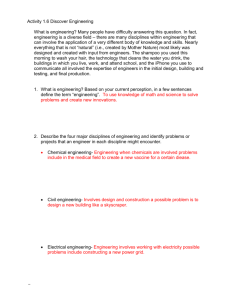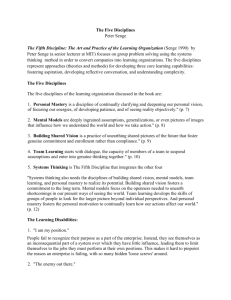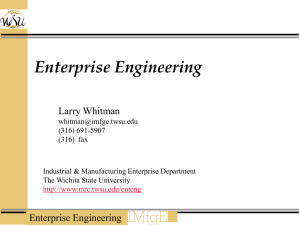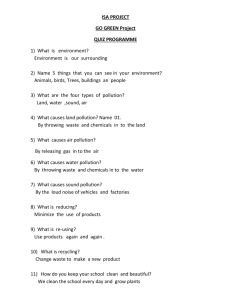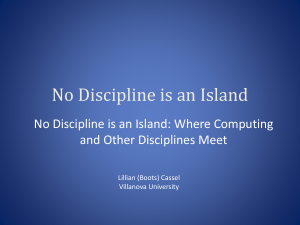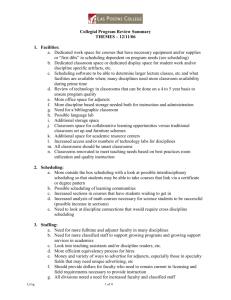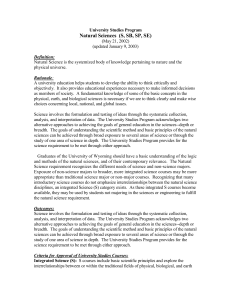To Sample Paper - Vadodara Institute of Engineering
advertisement
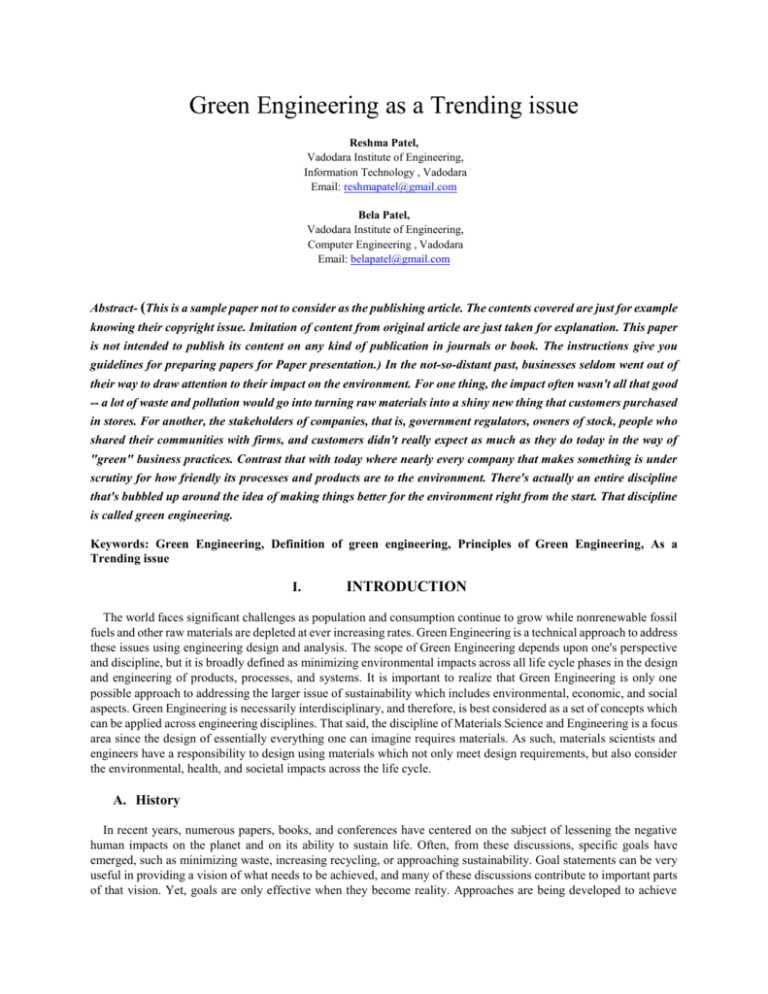
Green Engineering as a Trending issue Reshma Patel, Vadodara Institute of Engineering, Information Technology , Vadodara Email: reshmapatel@gmail.com Bela Patel, Vadodara Institute of Engineering, Computer Engineering , Vadodara Email: belapatel@gmail.com Abstract- (This is a sample paper not to consider as the publishing article. The contents covered are just for example knowing their copyright issue. Imitation of content from original article are just taken for explanation. This paper is not intended to publish its content on any kind of publication in journals or book. The instructions give you guidelines for preparing papers for Paper presentation.) In the not-so-distant past, businesses seldom went out of their way to draw attention to their impact on the environment. For one thing, the impact often wasn't all that good -- a lot of waste and pollution would go into turning raw materials into a shiny new thing that customers purchased in stores. For another, the stakeholders of companies, that is, government regulators, owners of stock, people who shared their communities with firms, and customers didn't really expect as much as they do today in the way of "green" business practices. Contrast that with today where nearly every company that makes something is under scrutiny for how friendly its processes and products are to the environment. There's actually an entire discipline that's bubbled up around the idea of making things better for the environment right from the start. That discipline is called green engineering. Keywords: Green Engineering, Definition of green engineering, Principles of Green Engineering, As a Trending issue I. INTRODUCTION The world faces significant challenges as population and consumption continue to grow while nonrenewable fossil fuels and other raw materials are depleted at ever increasing rates. Green Engineering is a technical approach to address these issues using engineering design and analysis. The scope of Green Engineering depends upon one's perspective and discipline, but it is broadly defined as minimizing environmental impacts across all life cycle phases in the design and engineering of products, processes, and systems. It is important to realize that Green Engineering is only one possible approach to addressing the larger issue of sustainability which includes environmental, economic, and social aspects. Green Engineering is necessarily interdisciplinary, and therefore, is best considered as a set of concepts which can be applied across engineering disciplines. That said, the discipline of Materials Science and Engineering is a focus area since the design of essentially everything one can imagine requires materials. As such, materials scientists and engineers have a responsibility to design using materials which not only meet design requirements, but also consider the environmental, health, and societal impacts across the life cycle. A. History In recent years, numerous papers, books, and conferences have centered on the subject of lessening the negative human impacts on the planet and on its ability to sustain life. Often, from these discussions, specific goals have emerged, such as minimizing waste, increasing recycling, or approaching sustainability. Goal statements can be very useful in providing a vision of what needs to be achieved, and many of these discussions contribute to important parts of that vision. Yet, goals are only effective when they become reality. Approaches are being developed to achieve these goals across disciplines, industries, and sectors. It is clear, however, that these approaches are currently neither systematic nor comprehensive. Green engineering focuses on how to achieve sustainability through science and technology. The Principles of Green Engineering provide a framework for scientists and engineers to engage in when designing new materials, products, processes, and systems that are benign to human health and the environment. A design based on these principles moves beyond baseline engineering quality and safety specifications to consider environmental, economic, and social factors. B. As a Trending Issue Green engineering approaches the design of products and processes by applying financially and technologically feasible processes and products in a manner that simultaneously decreases the amount of pollution that is generated by a source, minimizes exposures to potential hazards (including reducing toxicity and improved uses of matter and energy throughout the life cycle of the product and processes). In so doing, the overall health and ecological stress and risk are reduced. As such, green engineering is not actually an engineering discipline in itself, but an overarching engineering framework for all design disciplines. II. Principles of Green Engineering The American Chemical Society has expanded these to twelve principles: 1) Inherent Rather Than Circumstantial - Designers need to strive to ensure that all materials and energy inputs and outputs are as inherently nonhazardous as possible. 2) Prevention Instead of Treatment - It is better to prevent waste than to treat or clean up waste after it is formed. 3) Design for Separation - Separation and purification operations should be designed to minimize energy consumption and materials use. 4) Maximize Efficiency - Products, processes, and systems should be designed to maximize mass, energy, space, and time efficiency. 5) Output-Pulled Versus Input-Pushed - Products, processes, and systems should be "output pulled" rather than "input pushed" through the use of energy and materials. 6) Conserve Complexity - Embedded entropy and complexity must be viewed as an investment when making design choices on recycle, reuse, or beneficial disposition. 7) Durability Rather Than Immortality - Targeted durability, not immortality, should be a design goal. 8) Meet Need, Minimize Excess - Design for unnecessary capacity or capability (e.g., "one size fits all") solutions should be considered a design flaw. 9) Minimize Material Diversity - Material diversity in multicomponent products should be minimized to promote disassembly and value retention. 10) Integrate Material and Energy Flows - Design of products, processes, and systems must include integration and interconnectivity with available energy and materials flows. 11) Design for Commercial "Afterlife" - Products, processes, and systems should be designed for performance in a commercial "afterlife." 12) Renewable Rather Than Depleting - Material and energy inputs should be renewable rather than depleting. III. System Approach To varying extents, all engineering disciplines engage in green engineering. This includes sustainable design, life cycle analysis (LCA), pollution prevention, and design for the environment (DfE), design for disassembly (DfD), and design for recycling (DfR). As such, green engineering is a subset of sustainable engineering. Green engineering involves four basic approaches to improve processes and products to make them more efficient from an environmental standpoint. 1. Waste reduction; 2. Materials management; 3. Pollution prevention; and, 4. Product enhancement. Green engineering approaches design from a systematic perspective, which means that numerous professional disciplines must be integrated. In addition to all engineering disciplines, green engineering includes land use planning, architecture, landscape architecture, and other design fields, as well as the social sciences(e.g. to determine how various groups of people use products and services. Designers have always been concerned with space. Architects consider the sense of place. Engineers view the site map as a set of fluxes across the boundary. Planners consider the combinations of these systems over larger regions, e.g. urban areas. The life cycle analysis is important green engineering tool, which provides a holistic view of the entirety of a product, process or activity, encompassing raw materials, manufacturing, transportation, distribution, use, maintenance, recycling, and final disposal. In other words, assessing its life cycle should yield a complete picture of the product. The first step in a life cycle assessment is to gather data on the flow of a material through an identifiable society. Once the quantities of various components of such a flow are known, the important functions and impacts of each step in the production, manufacture, use, and recovery/disposal are estimated. Thus, in sustainable design, engineers must optimize for variables that give the best performance in temporal frames. The systems approach employed in green engineering is similar to value engineering (VE). Daniel A. Vallero considers green engineering to be a form of VE because both systems require that all elements and linkages within the overall project be considered to enhance the value of the project. Both are types of engineering optimization wherein the individual components must be integrated into the most effective system. Every component and step of the system must be challenged. Ascertaining overall value is determined not only be a project's cost-effectiveness, but other values, including environmental and public health factors. Thus, the broader sense of VE is compatible with and can be identical to green engineering, since VE is aimed at effectiveness, not just efficiency, i.e. a project is designed to achieve multiple objectives, without sacrificing any important values. Efficiency is a necessary but insufficient component of effectiveness. Efficiency is an engineering and thermodynamic term for the ratio of an input to an output of energy and mass within a system. As the ratio approaches 100%, the system becomes more efficient. Effectiveness requires that efficiencies be met for each component, but also that the integration of components lead to an effective, multiple value-based design. Green engineering is also a type of concurrent engineering, since tasks must be parallelized to achieve multiple design objectives. IV. CONCLUSION Green Engineering is the design commercialization and use of processes and products that are technically and economically feasible while minimizing: A. Generation of pollution at the source B. Risk to human health and the environment REFERENCES [1] Albaz.Young,“Synthetic structure findustrial plastics,”in Plastics, 2nded., vol. 3, J. Peters, Ed. New York: McGraw-Hill,1964,pp.15–64. [2] Chen K., “Title of chapter in the book,” in Title of His Published Book, edition xth ed. Publication


